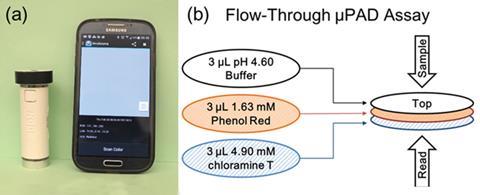Cheap and simple bromide sensor warns if water has been contaminated with fracking fluid

Fracking involves forcing large amounts of fracking fluid – a mix of water, sand, biocides and other chemicals – into shale fractures at high pressure to extract shale gas. The resulting wastewater contains high concentrations of toxic chemicals including bromide, chloride and iodide ions and organic pollutants, and some wells can use around 17,000 cubic metres of water. Municipal treatment plants cannot cope with this volume of waste, and toxic halogenated byproducts can be created by the disinfection process.
There are concerns that fracking wastewater will reach drinking water sources but currently there are no sensors for this specific type of contamination. Most water samples contain around 1ppm bromide but concentrations as high as 56ppm have been recorded in fracking wastewater. Now, Vincent Remcho and his team at Oregon State University in the US have made a simple device to test for these characteristically high levels of bromide ions.
‘The test allows you to screen water samples for bromide in the field rather than in the lab. It gives you a real-time assay,’ comments Robert Jackson, an environmental specialist at Stanford University in the US.

The device consists of 3 sheets of filter paper stacked vertically, each with a dried spot of reagent: the top sheet contains a buffer, and the middle and bottom sheet contain phenol red and chloramine T trihydrate, respectively. Contaminated water samples dropped onto the top sheet of paper initiate a yellow to blue colour change as chloramine T oxidizes any bromide in the sample which leads to the bromination of phenol red. The colour change on the bottom sheet is proportional to the bromide concentration and can be recorded with a portable detector and the result wirelessly delivered to a smartphone. ‘This work demonstrates that our device fabrication methods and detection approaches are practical and have potential for application not only in environmental monitoring but also in medical monitoring and pharmaceutical adulteration studies’ says Remcho.
The team are now testing their device with field samples to check for possible interferences. They are also looking into adapting the design to make it more suitable for manufacturing on a large scale.
References
This article is free to access until 1 October 2015. Download it here:
L J Loh et al, Analyst, 2015, 140, 5501 (DOI: 10.1039/c5an00807g)












No comments yet